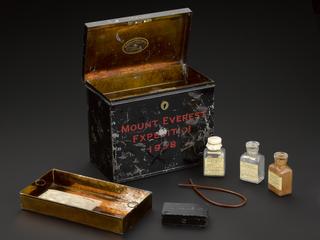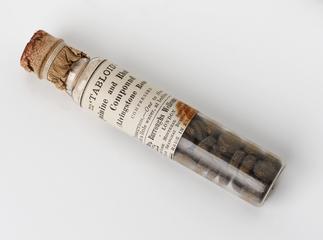






Medicine chest with 2 drawers, mahogany, containing 38 phials and 6 bottles of homeopathic medicines, also Homoeopathic Vade Mecum Medical and Surgical by Ruddock, 1877 ed., parts of stethoscope and enema syringe and styptic pencil, made in England, 1880-1920
Doctors used medicine chests such as this mahogany example as home remedy kits. This homeopathic medicine chest was manufactured by B. C. Garratt of Stoke Newington. It contains 38 phials and six bottles of homeopathic medicines. Homeopathy relies on the idea that ‘like cures like’. For example, treatment for vomiting is something that causes vomiting but in a smaller, much diluted dose. The chest also contains a monaural stethoscope, an enema syringe and a book titled ‘Homoeopathic Vade Mecum of Modern Medicine and Surgery’. The book is by E. Harris Ruddock. It is commonly used today by homeopaths worldwide. This edition was published by the Homeopathic Publishing Company in 1877.
Homeopathy was founded by Samuel Hahnemann (1755-1843). It was brought to England in the 1830s. There were over 80 homeopathic practitioners in London by the 1870s. There was friction with the traditional medical establishment. However, pharmacists quickly exploited interest in the new remedies.
Details
- Category:
- Materia Medica & Pharmacology
- Collection:
- Sir Henry Wellcome's Museum Collection
- Object Number:
- A21810
- Materials:
- mahogany, brass and leatherette
- Measurements:
-
overall: 165 mm x 280 mm x 200 mm,
- type:
- medicine chest




